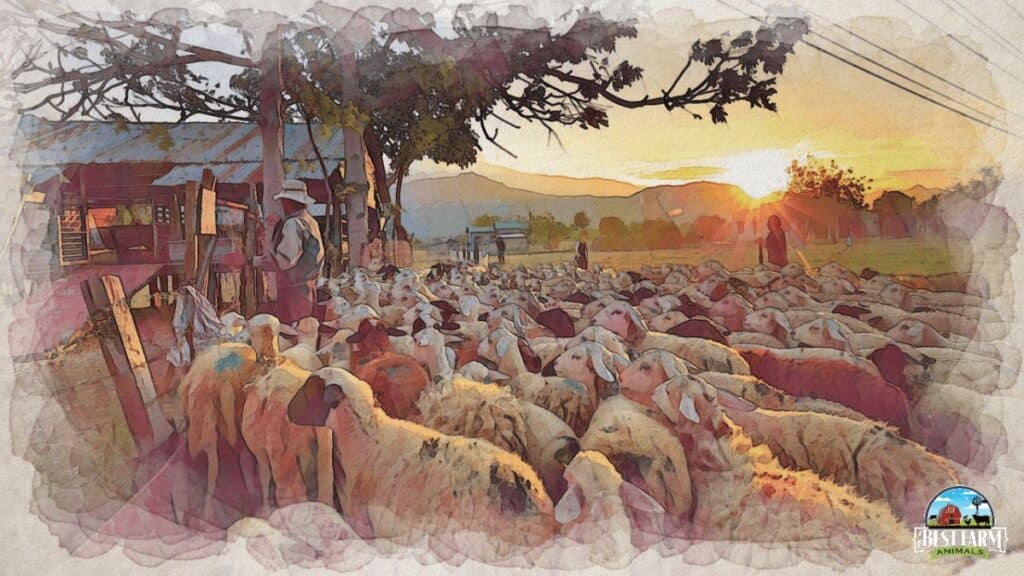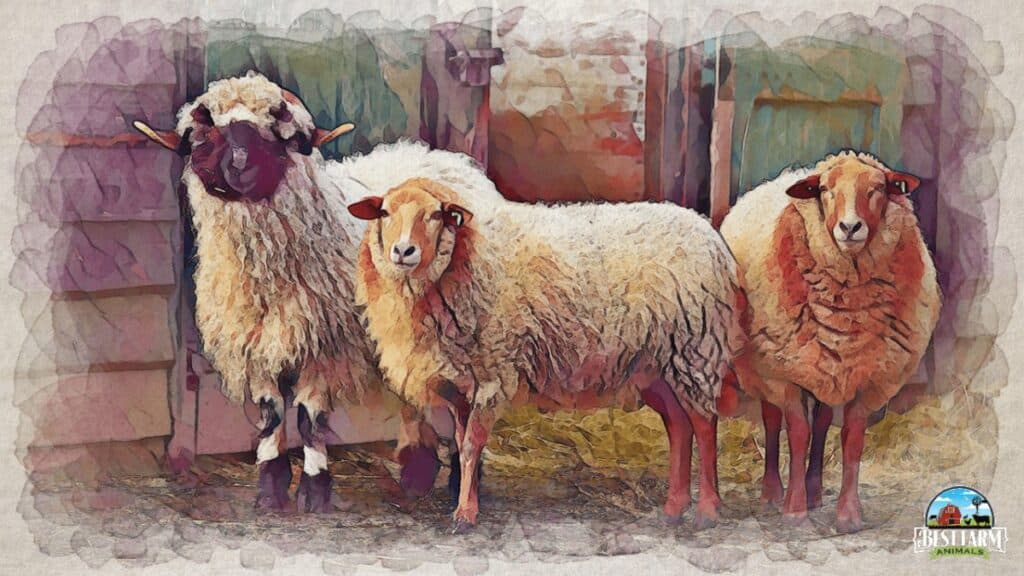Raising sheep is fun, and it’s easy to do with just a little bit of land. You can raise sheep on as little as a half-acre of pasture or less if you buy feed. If you are considering raising sheep, the first step is to decide why you want to raise sheep and what you hope to accomplish.
One of my friends raises sheep so she can have quality meat for her family. But my family raises sheep primarily as part of the kid’s 4H adventures. Yet another friend breeds sheep to create high-quality genetic lines. It’s important to have an idea of why you want to raise sheep so you can narrow down the breeds and genetics you want for your family or business.
If you are looking for more resources on raising sheep, check out our Beginners Guide to Raising Sheep 101.
1. Raise Sheep For Meat
Raising meat sheep for homesteaders and small-scale farmers can be profitable and fulfilling. Meat sheep are typically bigger and more powerful than wool-producing sheep breeds because they are bred and raised for their ability to produce meat.
Sheep meat sells for a premium. Often sheep raisers sell the rams or yearlings for meat. Some breeds of sheep are more ideal for meat sheep than others.
To be successful at your sheep meat operation, you need to select the right breed of sheep. The Katahdin, Dorper, Suffolk, and Texel are a few of the most widely used meat sheep breeds. Select a breed that is best suited for your climate, management strategy, and marketing objectives because each breed has distinctive qualities.
The Katahdin breed is well-liked for producing meat because of its versatility in terms of climates and management techniques. Customers who care about their health will appreciate the high-quality, low-fat meat that Katahdin sheep are known for producing.
Dorper sheep, another well-liked meat breed, are renowned for their hardiness and adaptability to various environments.
Another meat breed well-known for its fast growth rates and premium meat is the Suffolk sheep, which is why commercial meat producers favor it.

2. Raising Sheep For Wool
The practice of raising sheep for wool is rewarding and enjoyable, and it has gained popularity in recent years. Due to the growing interest in crafts like felting, spinning, and knitting, the wool and wool-based products market is expected to continue expanding. The fundamentals of raising sheep for wool, such as choosing a breed and feeding, will be covered in this article.
Sheep produce different types of wool. Some farmers raise specialty sheep and grow premium wool that sells fore more. Other farmers sell wool for textile manufacturing or other types of products, such as carpets.
If you want to raise sheep for wool, choose the right breed. Selecting a breed appropriate for your climate and management style is the first step in raising sheep for wool. Many sheep breeds, including Merino, Corriedale, Romney, and Bluefaced Leicester, are raised for their wool. The fiber diameter, crimp, and staple length differ depending on the breed. It’s crucial to pick a breed that will flourish in the climate of your area and that will yield wool that suits your needs.
3. Raising Sheep For Milk
Sheep milk is a delicacy in many parts of the world. Its less well-known. But, its distinctive flavor and nutritional advantages is making sheeps’ milk more and more popular. Sheep milk has a higher protein and calcium content than cow milk and is also simpler to digest. The fundamentals of raising sheep for milk, including the breeds of sheep frequently used for milk production, their care and feeding, and how to milk them, will be covered in this article.
There really isn’t a distinctly “milk sheep breed,” but many sheep breeds are used to produce milk. Breeds like the East Friesian, Lacaune, and Awassi are the most popular for milk.
The Lacaune sheep is more prevalent in Europe while the East Friesian sheep are more frequently used for milk production milk in the United States. The Middle Eastern-bred Awassi sheep thrive in hot, arid climates.
Sheep milk has a much higher fat content than goat or cow milk. This makes it ideal for cheese making because it produces more cheese per volume than other types of milk. It freezes well and can be helpful for those who can’t drink cow’s milk.

4. Raise Sheep For Profit
Raising sheep is profitable for farmers, but it’s harder for most homesteaders because of the smaller flock sizes. It is possible for you to raise sheep for profit and establish a sustainable business with the right information and tools.
Sheep’s profit margin is narrower than some other farm animals. Hundreds of sheep are usually needed to cover the base costs of owning sheep and increase profits.
Another crucial component of raising sheep for profit is marketing. Farmers can sell their goods at regional farmers’ markets, to eateries or specialty shops, or directly to customers online. Maximizing profits and increasing product demand can both be achieved by building a strong brand and reputation.
The costs related to raising sheep must be considered when determining profitability. These might include labor, food, shelter, and veterinary services. However, these costs can be reduced and overall profitability can be raised with careful planning and management.
5. Raise Sheep To be Self-Sufficient
Not all sheep raisers want to make a profit. Some people want quality lamb meat, wool, or milk for their family for a fraction of the market cost. That’s ok! Raising sheep is an ideal way to meet that objective.
Raising sheep can provide your family a way to have healthier, tastier meat without paying premium prices for that food. Many homesteaders choose to raise sheep for meat, but then discover the joy of spinning wool, knitting, or fall in love with the creamy taste of sheep milk.

6. Raising a Lamb as a Pet
Raising a lamb as a pet is an awesome experience. Lambs are very social and can love people back (but they do need much daily, quality time to bond with people truly). Lambs are becoming popular as a house pet in recent years, and have been beloved as a child’s pet for hundreds of years. They are gentle and will follow a child around once trust is built.
Sheep are calm and docile. They can recognize and remember individual human faces for years. They love and bond to human owners and recognize their voices. They can be trained to obey different commands. Rams are not a good pet because they get aggressive. Sheep can even recognize and respond to emotions.
7. Raise Sheep For Grass Control
Sheep have a reputation for being helpful in lawn maintenance and can be an environmentally friendly choice for mowing grassy areas. Sheep can enhance urban landscapes by mowing lawns and lowering people’s stress levels, according to a study by UC Davis.
But it’s crucial to have a strong fence, separate areas for plants that sheep shouldn’t eat, a way to water the plants, and shelter for the animals. Also noteworthy is the fact that, while using sheep as lawn mowers might not be a viable option for most homeowners, it is an environmentally friendly choice for larger properties like Georgia Tech.
In fact, sheep have become very popular in the United States as an environmentally friendly way to control landscaping. They contribute manure back into the soil, enriching it. They trim and eat the grass down to about 2 inches from the ground, making them a great mowers. Sheep are better than goats at keeping a lawn healthy, but goats are better for weed control.
Conclusion
Sheep are fun and fairly easy to raise. But beware, once you’ve raised your first lamb- you might fall in love!
My Essential Sheep Supplies
This list contains affiliate products. Affiliate products do not cost more but helps to support BestFarmAnimals and our goal to provide farm animal owners with accurate and helpful information.
This little giant bucket fits on a fence and this one’s easy to carry.
A sturdy dog collar is essential. Don’t do rope (they’ll break and tangle) or chain (injury!).
A Black Water Tub is way nicer than buckets that tip over. I like to get a 20 or 30-gallon in each pen so my goats have plenty of water, but you can get 100-gallons if you have a lot of sheep in one pen.
Loose minerals in a small bag or a Purina 50 lb bag, and a mineral feeder for free-choice is the best option. One side holds minerals, and the other holds baking soda. Don’t feed sheep goat minerals because it usually contains copper- something that is fatal to sheep.
Hoof trimmers are a necessity because you’ll need to trim your sheep’s hooves every few months. These are nice for the price.
Shearers like these aren’t too costly but do a decent job. Sheep wool jams normal shearers and once you are ready, I’d recommend the ones from Premier 1 Supplies.
Don’t make the mistake I made by waiting to order a drench gun before you need it. I was surprised by how often I use it. It helps with bloating, dehydration, and other ailments. Here’s a good drench, but you can also drench a bloat solution or water if dehydrated.
Digital Thermometor for when your lambs act sick. You’ll need to know if their temps are too low or too high so you can accurately diagnose the issues.
Vetericyn for wound care. It makes a big difference in a speedy recovery.
These heavy duty clips for fences, to clip ropes to collars, and a million other uses. They are stronger than carabeeners, which we broke a dozen of before switching to these.

